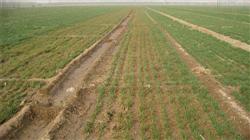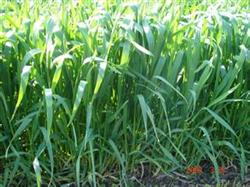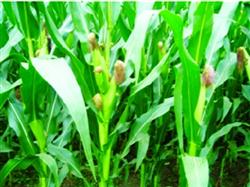Spring Management measures of Winter Wheat in Northern Xinjiang

Return to the green period to manage the spring rake in time after the beginning of spring (from the end of March to early April), with a depth of 5 cm. It is better to use a rake or oblique rake. Returning to green fertilizer should be applied on the eve or early stage of wheat turning green, and should be applied more in weak seedlings, little or no in strong seedlings, and not in prosperous seedlings. The total number of stems per mu is less than 400000 seedlings before winter. in the wheat field with weak wheat seedling growth, the late sowing wheat field should apply 8kg urea per mu on the eve of wheat turning green or in the early stage of wheat turning green, and apply it with a fertilizing machine and top dressing on snow or before rain. It is generally effective to control Monocotyledon weeds such as wild oats, bristlegrass and barnyardgrass in the field. 6.9% of Puma concentrated emulsion is sprayed on the leaves of weeds at the stage of 3-5 leaves with 50-60 ml per mu. Control dicotyledonous weeds such as Chenopodium, bitter borage, Artemisia annua, wild rape and other dicotyledonous weeds in the field. 72% 2mu 4murine D-butyl EC 50ml or 75% Baikuojing EC 50ml and 75% DuPont superstar suspension 1.2g were sprayed on the leaves of weeds at the 2th and 4th leaf stage. When the plant rate of wheat leafminer is more than 10%, or wheat aphids reach more than 500 per 100 plants, or wheat skin thrips reach more than 200 per 100 ears, 10% imidacloprid wettable powder or 1.8% avermectin should be used per mu. When the disease index of powdery mildew and rust reached 2030%, 25% triadimefon wettable powder or 12.5% uniconazole wettable powder was used. During the occurrence of bacterial leaf spot, 72% agricultural streptomycin or 2000 was used for control. Management of frost-damaged wheat fields in winter: according to the plant symptoms of frozen wheat, the frost injury can be divided into two types: the first is severe freezing injury, that is, the main stem and large tillers freeze to death, and the heart leaves dry. The second type is general freezing injury, the symptom is that the leaves are yellow and white and dry, but the main stem and tillers are not frozen to death. The remedial measures after the occurrence of freezing injury in winter: first, topdressing nitrogen fertilizer in time, applying available nitrogen fertilizer immediately after thawing in the field for the first time, applying 10 kg urea per mu and trenching to improve fertilizer efficiency; the second time in wheat jointing stage, jointing fertilizer was applied combined with watering and jointing fertilizer, 10 kg urea per mu was used. Late spring cold: strong cooling weather process is easy to occur in northern Xinjiang in spring, the lowest temperature is less than 0 ℃, the leaves are frozen and the main stems of some wheat fields die. Early spring prevention of cold injury in late spring: first, moderate inhibition of overgrowth in wheat fields, the main measures are suppression in early spring, spraying Zhuangfengan, Daizhuangsu and other inhibitors for chemical control. The second is irrigation to reduce the variation of surface temperature and increase soil temperature. Third, smoking raises the surface temperature and has the effect of reducing frost. In the north of Xinjiang, Changji, Tacheng, Yili Zhi and other places have frequent snow, and the snow cover is relatively thick. when the temperature rises in spring, the snow melts, it is easy to cause stagnant water in the field, resulting in poor root development of wheat, tender and weak plants, and lodging in the later stage, at the same time, the wheat field has high humidity and the occurrence of diseases, insect pests and weeds is aggravated. Therefore, do not irrigate green water, and pay attention to field drainage, especially in low-lying areas.
- Prev

There are skills in the control of wheat diseases and insect pests after spring.
March 20th is "the Spring Equinox", which is half of the ninety days of spring, hence the name. There is a folk proverb that "the Spring Equinox and the Autumn Equinox are equally divided day and night". After the Spring Equinox, the days were long and the nights were short, and the temperature was getting higher. The Spring Equinox has an important influence on agricultural production activities. For the north, the Spring Equinox is the beginning of spring.
- Next

The improved method of planting Spring Maize
Fresh corn is generally divided into sweet corn and waxy corn, which has unique flavor, rich nutrition, large market capacity, high yield and good benefit. The cultivation of spring corn is about 90 days from sowing to fresh ear harvest, which does not affect the planting of late hybrid rice. Planting fresh corn in spring should mainly grasp the following items: first of all, it should be selected.
Related
- The first cup of black tea in spring, the flavor and history of tea gardens in Kenya, Africa
- The computer can not only choose potatoes, but also grow tea rice. AI will grow winter oolong tea champion.
- It is not only the inflated tea bitten by insects, but also engraved with the four seasons tea in Beipu.
- The Oriental Beauty Tea Festival in Zhuxian County takes the stage at the weekend to experience the plus-size feast of oil tea.
- & quot; Oriental Beauty Tea & Exploration of Emei in Hsinchu, the hometown of quot;
- The new variety of strawberry "Tainong 1" dessert is the first choice with mellow aroma. Crimson gorgeous
- History of Tea in Taiwan: from Wild Inner Mountain to Export Tea Garden
- Two types of Taiwan Oriental Beauty Black Tea won the British three-Star Award for Childhood Tea Xiang Zhang Jiaqi changed from pilot to champion tea maker.
- Banana species and varieties: the planting history of Taiwan Xianren banana and dwarf banana is long, is banana disease resistant?
- Coffee planting Technology: Qianjie Coffee from Seedling to harvesting

